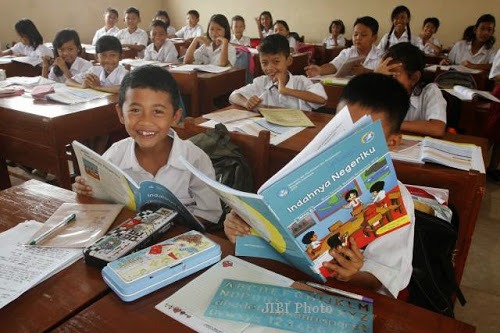Characteristics of Schools Implementing Active Learning
Active Learning is a concept of learning that is viewed in accordance with the demands of the latest learning. Therefore, each school should be able to implement and develop this active learning as well as possible. Referring to the idea of the Center for Curriculum Balitbang Kemendiknas (2010), the following are presented a number of indicators or characteristics of schools that have implemented an active learning process in terms of: (a) school expectations, creativity, and innovation; (b) human resources; (c) the environment, facilities, and learning resources; and (d) teaching and assessment process.

source
A. EXPECTATION OF SCHOOL, CREATIVITY, AND INNOVATION
Student learning achievement is more emphasized on "yielding" than "understanding".
Schools organize an educational and healthy 'competition' arena.
Eco-friendly schools (eg, plants or trees, po flowers, trash cans)
Better still if there are products / work of learners who have artistic value and economical / capital to be sold.
Better if there is exhibition of work of learners in a certain period of time, for example once in one year.
The work of learners is more dominant than the installation of various school attributes.
School life is more crowded, cheerful and cheerful.
School is neat, clean, and orderly.
The school community is polite, disciplined, and friendly.
The interest to get into the school is increasing.
Schools apply special selection to receive new learners.
There is a forum for channeling complaints of learners.
School climate is more democratic.
Organized intercellar competitions regularly and at the secondary education level there is a scientific learner contest.
There are program visits to learning resources in the community.
Learning activities in the syllabus and RPP emphasize active involvement of learners.
Learners learn and can explain about the school environment (for example, teacher's name, principal's name, and general matters at the school).
There is an internal teacher training program (inhouse training) on a regular basis.
There is a discussion forum or deliberation between the principal and teachers as well as other education personnel on a regular basis.
There are exchange programs, discussions or deliberations with partners from various stakeholders.
B. HUMAN RESOURCES
The principal cares and provides time to receive complaints and suggestions from learners and teachers.
Principals are open to management, especially financial management to teachers and parents / school committees.
The teacher acts as a facilitator in the learning process.
The teacher is familiar with the names of the learners.
Teachers are open to learners in terms of assessment.
The attitude of the teacher friendly and cheap smile to the students, and no physical and verbal abuse to learners.
Teachers are always trying to find new ideas in managing the class and developing learning activities.
Teachers show attitudes of love to learners.
Learners do a lot of observation in the environment and sometimes study outside the classroom.
Learners brave to ask the teacher.
Learners brave in expressing opinions.
Learners are not afraid to communicate with teachers.
Students work together regardless of differences in race, race, class and religion.
Learners are not afraid of the principal.
Learners enjoy reading in the library and there is a tendency to scramble to read books when it comes mobile library car.
Potential learners more explored and interest and talent learners more easily detected.
The expression of the learner looks happy in the learning process.
Learners often put forward ideas in the learning process.
Student's attention is not easily transferred to people / guests who come to school.
C. ENVIRONMENT, FACILITIES, AND LEARNING RESOURCES
Learning resources in school environments are used for learners.
There are wall magazines managed by learners that are regularly replaced with new students' work.
In the principal and teachers 'room there is a display of students' work.
No practice props are stacked in the principal's room or any other room until it is dusty.
The books are not stacked in the principal's room or in the other room.
The frequency of student visits to the school library room for reading / borrowing books is quite high.
In each class there is a display of the work of new learners.
There are various learning tools.
Different sources of learning are used.
D. LEARNING PROCESSES-TEACHING AND ASSESSMENT
To some extent, an integration approach is applied in the relevant learning-learning activities.
There appears to be cooperation between teachers for the interest of teaching and learning process.
In assessing the progress of teacher learning outcomes using a variety of ways in accordance with the indicators of competence. When the demands of the indicator perform a performance, which is assessed is the performance. When the demands of an indicator are related to con- scious understanding

Congratulations! This post has been upvoted from the communal account, @minnowsupport, by free1 from the Minnow Support Project. It's a witness project run by aggroed, ausbitbank, teamsteem, theprophet0, someguy123, neoxian, followbtcnews, and netuoso. The goal is to help Steemit grow by supporting Minnows. Please find us at the Peace, Abundance, and Liberty Network (PALnet) Discord Channel. It's a completely public and open space to all members of the Steemit community who voluntarily choose to be there.
If you would like to delegate to the Minnow Support Project you can do so by clicking on the following links: 50SP, 100SP, 250SP, 500SP, 1000SP, 5000SP.
Be sure to leave at least 50SP undelegated on your account.